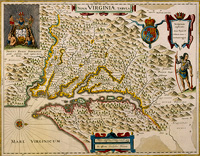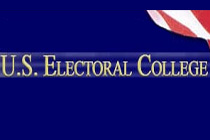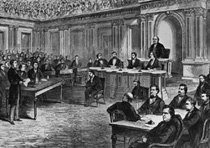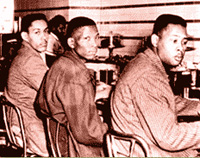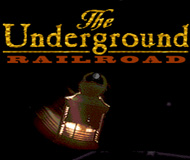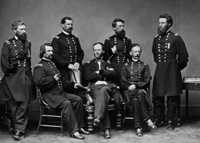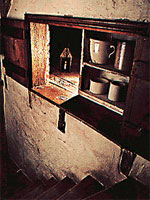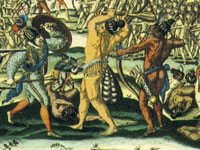Jefferson's Confidential Letter to Congress
Video One
- Monticello/illustration by Lucia Stanton.
- Oil, Shooting the Rapids, Frances Anne Hopkins, 1879. Library and Archives Canada, Acc. No. 1989-401-2.
- Oil on canvas, Image of View from Floyd's Grave, 1300 Miles above St. Louis, George Catlin, 1832. Smithsonian American Art Museum.
Video Two
- Oil on canvas, Mouth of the Platte River, 900 Miles above St. Louis, George Catlin, 1832. Smithsonian American Art Museum.
- Oil on canvas, Floyd's Grave, Where Lewis and Clark Buried Sergeant Floyd in 1804, George Catlin, 1832. Smithsonian American Art Museum.
- Oil on canvas, Young Omahaw, War Eagle, Little Missouri, and Pawnees, Charles Bird King, 1821. Smithsonian American Art Museum.
- Thomas Jefferson to Meriwether Lewis, Letter press copy of manuscript letter, June 20, 1803, Library of Congress, Manuscript Division.
- Charles M. Russell, Lewis and Clark on the Lower Columbia, 1905, Opaque and transparent watercolor over graphite underdrawing on paper, 18 3/4 x 23 7/8 inches, Amon Carter Museum, Fort Worth, Texas, 1961.195.
- Cherry's Fine Guns
- Google Books
- Harper's Weekly
- Independence National Historical Park, Philadelphia
- Live Auctioneers
- Monticello/Thomas Jefferson Foundation, Inc.
- National Archives and Records Administration
- New York Public Library Digital Gallery
- Sondra Kicklighter, Photo.net
Historian Leah Glaser analyzes a letter to the U.S. Congress from Thomas Jefferson requesting funding for the Lewis and Clark expedition. In this letter, Jefferson explains his rationale and his vision for the future of the country. Glaser models several historical thinking skills, including:
- (1) close reading of the letter to explore Jefferson’s language and thinking about American Indians and the future of the United States;
- (2) attention to key source information, such as the date of the letter and the audience; and
- (3) placing the letter within a larger context, using it to explore Jefferson’s vision of an agrarian nation, relations with American Indians, westward expansion, and political strategy in the early 19th century.
This is called "Jefferson's Confidential Letter to Congress," and it certainly is more than it seems. It's often put with the collection of the Lewis and Clark Corps of Discovery materials. And essentially it's the letter where he asks for money from Congress, for getting money for the Corps of Discovery. And he asked for $2,500, but it's not till the very end. And what's interesting about it and the reason I like it and I teach with it, is because it's clearly not about the money. He's trying to tell Congress a much bigger story, and you really get a large idea in this one little letter of his whole theory of where the country should go and expansion and his philosophy of expansion and Indian policy and where Congress fits into it.
At the beginning you get no indication that he's going to be asking for money and what it's for or anything like that. But I think the most important phrase here is that he ends with "the public good" because that's going to be a theme throughout the letter.
Then he says, "The Indian tribes residing within the limits of the United States have, for a considerable time, been growing more and more uneasy at the constant diminution of the territory they occupy, although affected by their own voluntary sales, and the policy has long been gaining strength with them of refusing absolutely all further sale on any conditions, insomuch at this time, it hazards their friendship and excites dangerous jealousies in their minds to make any overture for the purchase of the smallest portions of their land. Very few tribes only are not yet obstinately in these dispositions."
So basically he's saying that, you know, we've been purchasing land from these Indian tribes, and all of a sudden they're not very happy about it anymore and they won't do it anymore, so we're going to have to figure something else out.
"First, to encourage them to abandon hunting, to apply to the raising stock, to agriculture and domestic manufacture, and thereby prove to themselves that less land and labor will maintain them in this, better than in their former mode of living. The extensive forests necessary in the hunting life will then become useless, and they will see advantage in exchanging them for the means of improving their farms, and of increasing their domestic comforts."
This is my favorite part of this letter, because it's basically trying to ask the Indians to do what he wants everybody to do: to be yeoman farmers. And a yeoman farmer is Jefferson's dream of the agrarian nation. The self-reliant, independent farmer who lives off his own land, and the idea that everybody will have their own land and nobody, you know, will be dependent on anybody else, and we will all be equal.
And basically he's saying we need to convince the Indians of this, too, and once they just farm they won't need any of that hunting land, and we can then easily take it from them. It won't be this big struggle. And, so this is basically a policy of assimilation. "We need them to be like us, and then they won't need all that land anymore.'
And then secondly, "To multiply trading houses among them, and place within their reach those things which will contribute more to their domestic comfort than the possession of extensive, but uncultivated, wilds. Experience and reflection will develop to them the wisdom of exchanging what they can spare and we want, for what we can spare and they want. In leading them to agriculture, to manufactures, and to civilization, in bringing together their and our settlements, and in preparing them ultimately to participate in the benefit of our governments, I trust and believe we are acting in their greatest good."
So again, we make them like our stuff, we trade stuff with them. They become sort of part of our economic system, and they become more like us, and we won't have necessarily all this conflict.
And then finally gets to that last paragraph. "While the extension of the public commerce among the Indian tribes may deprive of that source of profit such of our citizens as are engaged in it, it might be worthy the attention of Congress, in their care of individual as well as in the general interest, to the point in another direction, the enterprise of these citizens as profitably for themselves and more usefully for the public."
This again he's talking about that greater good. Yeah, there's people making money, individuals making money, but this is the bigger picture.
"It is, however, understood, that the country on that river is inhabited by numerous tribes, who furnish great supplies of furs and peltry to the trade of another nation, carried on in a high latitude through an infinite number of portages and lakes, shut up by ice through a long season. The commerce on that line could bear no competition with that of the Missouri, traversing a moderate climate, offering no competition to the best accounts, a continued navigation from its source, and possibly, with a single portage from the Western Ocean, and finding to the Atlantic a choice of channels through the Illinois or Wabash, the lakes of the Hudson, through the Ohio, the Susquehanna, or the Potomac or James rivers, and through the Tennessee and Savannah rivers."
That one line is a little sneak in here of a very important concept, which people argue was the principal reason for the Lewis and Clark expedition, and that was the Northwest Passage, all those rivers he's talking about. This theory that he has, sitting in Virginia, that there's an all-water route from the Atlantic to the Pacific. And so while we're doing this stuff with the trading houses, you know, we might just be able to find this all-water route to the Pacific.
I guess you tend to hear about the Louisiana Purchase. He's surprised, and just happens, "Oh, I wasn't thinking that at all." But you see with the date of this letter in January of 1803, that he was thinking about this area a lot before the opportunity presented itself and might have already heard rumors that France wanted to dump this land. Spain had been caring for it for a while. France was now not able to deal with all that territory. And certainly, he was not perhaps anticipating the whole block of it, but he certainly had his eye on it.
Well, we talk a lot about Jefferson's theory of the agrarian nation beforehand. I talk a lot about the yeoman farmer and the values of property and the whole—John Locke's vision of life, liberty, and property, not the pursuit of happiness, but that idea of property, even though it's dropped from the Declaration of Independence, still maintains, you know, great power and investment in his mind.
And so we talk a lot, especially when we talk about the West, of that idea of the agrarian nation. This vision that this is America's garden, and it's going—this is how we're going to be different from Europe. This is how we're going to get away from the original sin of slavery. We're not going to depend on anybody.
I give a little background about Washington's civilization program and the role that Indians play in the Constitution, then I sort of give them this and it pulls it all together a little bit, Jefferson ties it all together. And then the next day we talk about Lewis and Clark, basically, and they read his instructions. We don't pick apart every sentence necessarily, but I sort of just ask them to get into groups and outline the argument. Outline how he gets from the beginning to asking for money. What is his argument and what is he asking them to do? Why is he putting this in terms of commerce, and what does that have to do with Indians? Where do Lewis and Clark, you know, come in in all of this? How does he convince Congress that it's in their interest to fund this expedition?
Sometimes I have them read the original and sometimes I give them both, because if they really try—Jefferson has pretty good handwriting, and so they can get most of it. You know, the limitations are it's a little wordy in areas. And it is a complex argument, but that's kind of the point of the document. That's why I like it, because he makes a very simple request very complicated.
I think there's a lot of different documents as I said that would be a lot simpler, like the list given to the Indians. But, that gets specifically to the Lewis and Clark expedition. And what I think is a bonus about this is it's the precursor to the Lewis and Clark expedition, and it gives the plan in the beginning, that it wasn't all just haphazard, and that even though plans didn't always go well, over and over, the United States really did stick to Jefferson's vision as best it could. Just kept insisting the West was this place for an agrarian nation, and we're going to make it so, until [our nature] comes back and says, "No, that's not—this is not like the East. This is a different place." Even great men like Jefferson perhaps misunderstood it, but this misunderstanding is important to understand, because it had ramifications.
